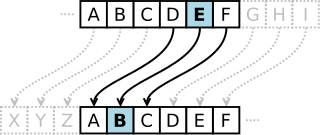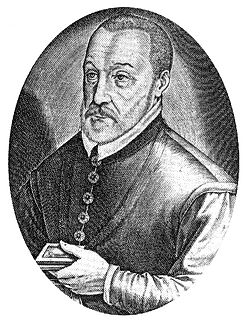Related Research Articles
In cryptography, a substitution cipher is a method of encrypting in which units of plaintext are replaced with the ciphertext, in a defined manner, with the help of a key; the "units" may be single letters, pairs of letters, triplets of letters, mixtures of the above, and so forth. The receiver deciphers the text by performing the inverse substitution process to extract the original message.
In cryptography, a transposition cipher is a method of encryption by which the positions held by units of plaintext are shifted according to a regular system, so that the ciphertext constitutes a permutation of the plaintext. That is, the order of the units is changed. Mathematically a bijective function is used on the characters' positions to encrypt and an inverse function to decrypt.

In cryptography, a Caesar cipher, also known as Caesar's cipher, the shift cipher, Caesar's code or Caesar shift, is one of the simplest and most widely known encryption techniques. It is a type of substitution cipher in which each letter in the plaintext is replaced by a letter some fixed number of positions down the alphabet. For example, with a left shift of 3, D would be replaced by A, E would become B, and so on. The method is named after Julius Caesar, who used it in his private correspondence.

The Vigenère cipher is a method of encrypting alphabetic text by using a series of interwoven Caesar ciphers, based on the letters of a keyword. It employs a form of polyalphabetic substitution.

An autokey cipher is a cipher that incorporates the message into the key. The key is generated from the message in some automated fashion, sometimes by selecting certain letters from the text or, more commonly, by adding a short primer key to the front of the message.

In cryptography, the tabula recta is a square table of alphabets, each row of which is made by shifting the previous one to the left. The term was invented by the German author and monk Johannes Trithemius in 1508, and used in his Trithemius cipher.

In cryptanalysis, frequency analysis is the study of the frequency of letters or groups of letters in a ciphertext. The method is used as an aid to breaking classical ciphers.

The Playfair cipher or Playfair square or Wheatstone–Playfair cipher is a manual symmetric encryption technique and was the first literal digram substitution cipher. The scheme was invented in 1854 by Charles Wheatstone, but bears the name of Lord Playfair for promoting its use.

In cryptography, ciphertext or cyphertext is the result of encryption performed on plaintext using an algorithm, called a cipher. Ciphertext is also known as encrypted or encoded information because it contains a form of the original plaintext that is unreadable by a human or computer without the proper cipher to decrypt it. This process prevents the loss of sensitive information via hacking. Decryption, the inverse of encryption, is the process of turning ciphertext into readable plaintext. Ciphertext is not to be confused with codetext because the latter is a result of a code, not a cipher.
The affine cipher is a type of monoalphabetic substitution cipher, where each letter in an alphabet is mapped to its numeric equivalent, encrypted using a simple mathematical function, and converted back to a letter. The formula used means that each letter encrypts to one other letter, and back again, meaning the cipher is essentially a standard substitution cipher with a rule governing which letter goes to which. As such, it has the weaknesses of all substitution ciphers. Each letter is enciphered with the function (ax + b) mod 26, where b is the magnitude of the shift.
In cryptography, the ADFGVX cipher was a manually applied field cipher used by the Imperial German Army during World War I. It was used to transmit messages secretly using wireless telegraphy. ADFGVX was in fact an extension of an earlier cipher called ADFGX which was first used on 1 March 1918 on the German Western Front. ADFGVX was applied from 1 June 1918 on both the Western Front and Eastern Front.
In classical cryptography, the bifid cipher is a cipher which combines the Polybius square with transposition, and uses fractionation to achieve diffusion. It was invented around 1901 by Felix Delastelle.
In cryptography, a classical cipher is a type of cipher that was used historically but for the most part, has fallen into disuse. In contrast to modern cryptographic algorithms, most classical ciphers can be practically computed and solved by hand. However, they are also usually very simple to break with modern technology. The term includes the simple systems used since Greek and Roman times, the elaborate Renaissance ciphers, World War II cryptography such as the Enigma machine and beyond.

In classical cryptography, the Hill cipher is a polygraphic substitution cipher based on linear algebra. Invented by Lester S. Hill in 1929, it was the first polygraphic cipher in which it was practical to operate on more than three symbols at once.
The rail fence cipher is a form of classical transposition cipher. It derives its name from the manner in which encryption is performed.
The four-square cipher is a manual symmetric encryption technique. It was invented by the French cryptographer Felix Delastelle.
Polygraphic substitution is a cipher in which a uniform substitution is performed on blocks of letters. When the length of the block is specifically known, more precise terms are used: for instance, a cipher in which pairs of letters are substituted is bigraphic.
In the history of cryptography, a grille cipher was a technique for encrypting a plaintext by writing it onto a sheet of paper through a pierced sheet. The earliest known description is due to the polymath Girolamo Cardano in 1550. His proposal was for a rectangular stencil allowing single letters, syllables, or words to be written, then later read, through its various apertures. The written fragments of the plaintext could be further disguised by filling the gaps between the fragments with anodyne words or letters. This variant is also an example of steganography, as are many of the grille ciphers.

The Alberti Cipher, created in 1467 by Italian architect Leon Battista Alberti, was one of the first polyalphabetic ciphers. In the opening pages of his treatise De componendis cifris he explained how his conversation with the papal secretary Leonardo Dati about a recently developed movable type printing press led to the development of his cipher wheel.

BATCO, short for Battle Code, is a hand-held, paper-based encryption system used at a low, front line level in the British Army. It was introduced along with the Clansman combat net radio in the early 1980s and was largely obsolete by 2010 due to the wide deployment of the secure Bowman radios. BATCO consists of a code, contained on a set of vocabulary cards, and cipher sheets for superencryption of the numeric code words. The cipher sheets, which are typically changed daily, also include an authentication table and a radio call sign protection system.
References
- ↑ "TICOM I-20 Interrogation of SonderFuehrer Dr Fricke of OKW/CHI". sites.google.com. NSA. 28 June 1945. p. 2. Retrieved 29 August 2016.
- ↑ Traité élémentaire de cryptographie. 1902. pp. 80–81. Retrieved 7 December 2019.
- ↑ Friedman, William F. (1931). Advanced Military Cryptography (PDF). Chief Signal Officer. Retrieved 7 December 2019.
- ↑ Callimahos, Lambros D. (1965). "Collier's Encyclopedia" . Retrieved 7 December 2019.
- ↑ Machiavelli (Mccready, Warren Thomas) (1972). "The Twosquare Cipher". The Cryptogram (Nov-Dec 1972): 152–153.
- ↑ American Cryptogram Association. "Cipher Types" . Retrieved 7 December 2019.
- ↑ Currer-Briggs, Noel (1987). "Some of ultra's poor relations in Algeria, Tunisia, Sicily and Italy". Intelligence and National Security. 2 (2): 274–290. doi:10.1080/02684528708431890.
- ↑ WGBH Educational Foundation. "The Double Playfair Cipher". 2000.
- ↑ Noel Currer-Briggs. "Army Ultra's Poor Relations" a section in Francis Harry Hinsley, Alan Stripp. "Codebreakers: The Inside Story of Bletchley Park". 2001. p. 211
- ↑ Schick, Joseph S. (1987). "With the 849th SIS, 1942-45". Cryptologia. 11 (1): 29–39. doi:10.1080/0161-118791861767.
- ↑ David, Charles (1996). "A World War II German Army Field Cipher and how we broke it". Cryptologia. 20 (1): 55–76. doi:10.1080/0161-118791861767.
- ↑ Bowers, William Maxwell (1959). Digraphic substitution: the Playfair cipher, the four square cipher. American Cryptogram Association. p. 25.